-

新人教版高中英语选修2Unit 3 Learning about Language教学设计
1. We'll need ten months at least to have the restaurant decorated.2.Some traditional Chinese dishes from before the Ming Dynasty are still popular today.3.My grandpa's breakfast mainly includes whole grain biscuits and a glass of milk.4.People in this area would eat nearly a kilo of cheese per week.5. We enjoyed a special dinner in a fancy restaurant where the waiters all wore attractive suits.6. He prefers this brand of coffee which, as he said, has an unusually good flavor.Key:1. at a minimum 2. prior to3. consist of4. consume5. elegant6. exceptionalStep 5:Familiarize yourself with some food idioms by matching the meaning on the right with the colored words on the left.1.Public concern for the health of farm animals has mushroomed in the UK2.Anderson may be young but he's certainly rolling to doing dough!3.George is a popular lecturer. He often peppers his speech with jokes.4.As the person to bring home the bacon, he needs to find a stable job.5 He is often regarded as a ham actor for his over emphasized facial expressions. The media reported that these companies had treated pollution as a hot potato. 6.The media reported that these companies had treated pollution as a hot potato.7.Don't worry about the test tomorrow. It's going to be a piece of cake!8. It's best to fold the swimming ring when it is as flat as a pancake.A. completely flatB. something that is very easy to do C.an issue that is hard to deal withD.to include large numbers of somethingE.to earn on e's living to support a familyF. wealthyG.to rapidly increase in numberH. an actor who performs badly, especially by over emphasizing emotions

新人教版高中英语选修2Unit 3 Reading for writing教学设计
The theme of this part is to write an article about healthy diet. Through reading and writing activities, students can accumulate knowledge about healthy diet, deepen their understanding of the theme of healthy diet, and reflect on their own eating habits. This text describes the basic principles of healthy diet. The author uses data analysis, definition, comparison, examples and other methods. It also provides a demonstration of the use of conjunctions, which provides important information reference for students to complete the next collaborative task, writing skills, vivid language materials and expressions.1. Teach Ss to learn and skillfully use the new words learned from the text.2. Develop students’ ability to understand, extract and summarize information.3. Guide students to understand the theme of healthy diet and reflect on their own eating habits.4. To guide students to analyze and understand the reading discourse from the aspects of theme content, writing structure, language expression, etc., 5. Enable Ss to write in combination with relevant topics and opinions, and to talk about their eating habits.1. Guide students to analyze and understand the reading discourse from the aspects of theme content, writing structure, language expression, etc.2. Enable them to write in combination with relevant topics and opinions, and to talk about their eating habits.3. Guide the students to use the cohesive words correctly, strengthen the textual cohesion, and make the expression fluent and the thinking clear.Step1: Warming upbrainstorm some healthy eating habits.1.Eat slowly.2.Don’t eat too much fat or sugar.3.Eat healthy food.4.Have a balanced diet.Step2: Read the passage and then sum up the main idea of each paragraph.

新人教版高中英语选修2Unit 3 Using langauge-Listening教学设计
1. How is Hunan cuisine somewhat different from Sichuan cuisine?The heat in Sichuan cuisine comes from chilies and Sichuan peppercorns. Human cuisine is often hotter and the heat comes from just chilies.2.What are the reasons why Hunan people like spicy food?Because they are a bold people. But many Chinese people think that hot food helps them overcome the effects of rainy or wet weather.3.Why do so many people love steamed fish head covered with chilies?People love it because the meat is quite tender and there are very few small bones.4.Why does Tingting recommend bridge tofu instead of dry pot duck with golden buns?Because bridge tofu has a lighter taste.5 .Why is red braised pork the most famous dish?Because Chairman Mao was from Hunan, and this was his favorite food.Step 5: Instruct students to make a short presentation to the class about your choice. Use the example and useful phrases below to help them.? In groups of three, discuss what types of restaurant you would like to take a foreign visitor to, and why. Then take turns role-playing taking your foreign guest to the restaurant you have chosen. One of you should act as the foreign guest, one as the Chinese host, and one as the waiter or waitress. You may start like this:? EXAMPLE? A: I really love spicy food, so what dish would you recommend?? B: I suggest Mapo tofu.? A: Really ? what's that?

新人教版高中英语必修3Unit 1 Festivals and Celebrations教学设计三
*wide range of origins(= a great number of different origins, many kinds of origins)*It featured a parade and a great feast with music, dancing, and sports. (=A parade and a great feast with music, dancing, and sports were included as important parts of the Egyptian harvest festival.)*.. some traditions may fade away and others may be established.(= Some traditions may disappear gradually, while other new traditions may come into being.)Step 6 Practice(1) Listen and follow the tape.The teacher may remind the students to pay attention to the meaning and usage of the black words in the context, so as to prepare for the completion of the blanks in activity 5 and vocabulary exercises in the exercise book.(2) Students complete the text of activity 5 by themselves.The teacher needs to remind the students to fill in the blanks with the correct form of the vocabulary they have learned in the text.Students exchange their answers with their partners, and then teachers and students check their answers.(3)Finish the Ex in Activity 5 of students’ book.Step 7 Homework1. Read the text again, in-depth understanding of the text;2. Discuss the origin of festivals, the historical changes of related customs, the influence of commercial society on festivals and the connotation and essential meaning of festivals.3. Complete relevant exercises in the guide plan.1、通过本节内容学习,学生是否理解和掌握阅读文本中的新词汇的意义与用法;2、通过本节内容学习,学生能否结合文本特点快速而准确地找到主题句;3、通过本节内容学习,学生能否理清论说文的语篇结构和文本逻辑,了解节日风俗发展与变迁,感悟节日的内涵与意义。

新人教版高中英语必修3Unit 2 Morals and Virtues教学设计四
3.Teachers ask different groups to report the answers to the questions and ask them to try different sentence patterns.The teacher added some sentence patterns for students to refer to when writing.Step 4 Writing taskActivity 51.Write the first draft.Students first review the evaluation criteria in activity 5, and then independently complete the draft according to the outline of activity 4, the answers to the questions listed in the group discussion and report, and the reference sentence pattern.2.Change partners.The teacher guides the students to evaluate their partner's composition according to the checklist of activity 5 and proposes Suggestions for modification.3.Finalize the draft.Based on the peer evaluation, students revise their own compositions and determine the final draft.Finally, through group recommendation, the teacher selects excellent compositions for projection display or reading aloud in class, and gives comments and Suggestions.Step 5 Showing writingActivity 5T call some Ss to share their writing.Step 6 Homework1. Read the passage in this section to better understand the passage.2. Carefully understand the hierarchical structure of the article, and deeply understand the plot of the story according to the causes, process and results;3. Independently complete the relevant exercises in the guide plan.1、通过本节内容学习,学生是否理解和掌握阅读文本中的新词汇的意义与用法;2、通过本节内容学习,学生能否通过人物言行的对比分析道德故事的深层内涵;3、通过本节内容学习,学生能否根据故事的起因、经过和结果来深入理解故事的情节,从而了解文章的层次结构;4、结合现实生活案例发表自己的见解和看法,写一篇观点明确、层次分明的故事评论。

新人教版高中英语必修3Unit 2 Morals and virtues教学设计一
(2) students are divided into groups according to the requirements of activity 3. Each student shares a story of personal experience or hearing-witnessing kindness, and then selects the most touching story in the group and shares it with the whole class. Before the students share the story, the teacher can instruct them to use the words and sentence patterns in the box to express. For example, the words in the box can be classified:Time order: first of all, then, after that, later, finally logical relationship :so, however, although, butTeachers can also appropriately add some transitional language to enrich students' expression:Afterwards, afterwards, at last, in the end, eventuallySpatial order: next to, far from, on the left, in front ofOtherwise, nevertheless, as a result, therefore, furthermore, in addition, as well asSummary: in a word, in short, on the whole, to sum up, in briefStep 8 Homework1. Understand the definition of "moral dilemma" and establish a correct moral view;2. Accumulate vocabulary about attitudes and emotions in listening texts and use them to express your own views;3. Complete relevant exercises in the guide plan.1、通过本节内容学习,学生能否理解理解“道德困境”的定义;2、通过本节内容学习,学生能否通过说话人所表达的内容、说话的语气、语调等来判断其态度和情绪;3、通过本节内容学习,学生能否针对具体的道德困境发表自己的看法和见解,能否掌握听力理训练中的听力策略。
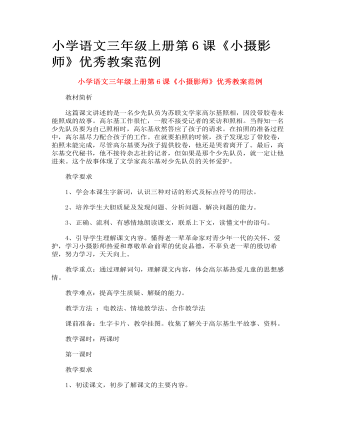
小学语文三年级上册第6课《小摄影师》优秀教案范例
介绍人物,导入新课 1、启发谈话。课前同学们自己已经读过了课文,查阅了有关资料,谁能向大家介绍一下高尔基? 2、学生之间交流收集的有关高尔基的资料。 3、师出示高尔基的画像,并归纳:高尔基(1886年~1936年),是苏联伟大的无产阶级文学家,世界著名的文学家。他写了很多书,发表了《童年》、《在人间》、《我的大学》、《母亲》等多部小说以及著名的散文诗《海燕》和一系列剧本。“书籍是人类进步的阶梯”这句脍炙人口的名言,就出自高尔基的笔下,全世界人民都很敬爱他。他的作品在我国广为流传,得到人们的喜爱。今天,我们来学习高尔基与一位小学生之间的故事:小摄影师。(板书,提示“摄”的读音。) 高尔基与小摄影师之间到底发生了什么事呢?我们下面来看课文
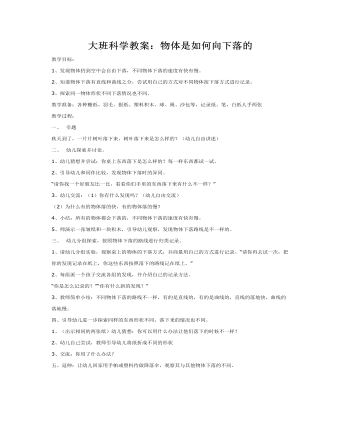
大班科学教案:物体是如何向下落的
一、 引题 秋天到了,一片片树叶落下来,树叶落下来是怎么样的?(幼儿自由讲述) 二、 幼儿探索并讨论。 1、幼儿猜想并尝试:你桌上东西落下是怎么样的?每一样东西都试一试。 2、引导幼儿和同伴比较,发现物体下落时的异同。 “请你找一个好朋友比一比,看看你们手里的东西落下来有什么不一样?” 3、幼儿交流:(1)你有什么发现吗?(幼儿自由交流) (2)为什么有的物体落的快,有的物体落的慢? 4、小结:所有的物体都会下落的,不同物体下落的速度有快有慢。 5、师演示一张皱纸和一块积木,引导幼儿观察,发现物体下落路线是不一样的。
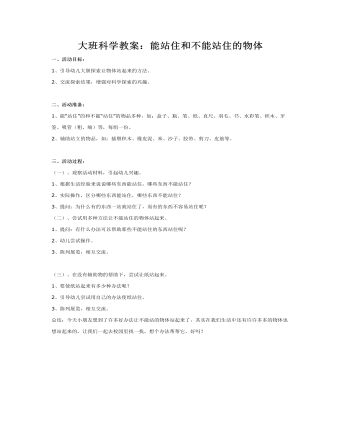
大班科学教案:能站住和不能站住的物体
二、活动准备:1、能“站住”的和不能“站住”的物品多种,如:盒子、瓶、笔、纸、直尺、羽毛、书、水彩笔、积木、牙签、吸管(粗、细)等,每组一份。2、辅助站立的物品,如:插塑积木、橡皮泥、米、沙子、胶带、剪刀、皮筋等。 三、活动过程:(一)、观察活动材料,引起幼儿兴趣。1、根据生活经验来说说哪些东西能站住,哪些东西不能站住?2、实际操作,区分哪些东西能站住,哪些东西不能站住?3、提问:为什么有的东西一站就站住了,而有的东西不容易站住呢?
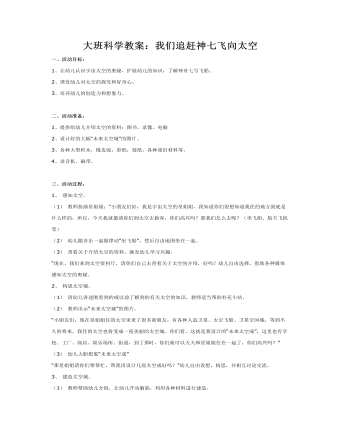
大班科学教案:我们追赶神七飞向太空
二、活动准备:1、提供给幼儿介绍太空的资料:图书、录像、电脑 2、设计好的大幅“未来太空城”的图片。 3、各种大型积木,橡皮泥,彩纸,皱纸,各种废旧材料等。 4、录音机、磁带。 三、活动过程:1、感知太空。 (1)教师扮演星姐姐:“小朋友们好,我是宇宙太空的星姐姐,我知道你们很想知道我住的地方到底是什么样的,所以,今天我就邀请你们到太空去做客,你们高兴吗?那我们怎么去呢?(坐飞船、航天飞机等) (2)幼儿随音乐一起做律动“坐飞船”,然后自由地围坐在一起。 (3)查看关于介绍太空的资料,激发幼儿学习兴趣。 “现在,我们来到太空资料厅,请你们自己去查看关于太空的介绍,好吗?幼儿自由选择,借助各种媒体感知太空的奥秘。
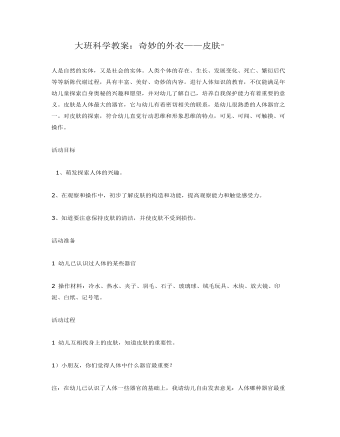
大班科学教案:奇妙的外衣——皮肤”
活动目标 1、萌发探索人体的兴趣。 2、在观察和操作中,初步了解皮肤的构造和功能,提高观察能力和触觉感受力。 3、知道要注意保持皮肤的清洁,并使皮肤不受到损伤。 活动准备 1 幼儿已认识过人体的某些器官 2 操作材料:冷水、热水、夹子、羽毛、石子、玻璃球、绒毛玩具、木块、放大镜、印泥、白纸、记号笔。 活动过程 1 幼儿互相找身上的皮肤,知道皮肤的重要性。 1)小朋友,你们觉得人体中什么器官最重要? 注:在幼儿已认识了人体一些器官的基础上,我请幼儿自由发表意见:人体哪种器官最重要?其目的在于复习以前学过的有关人体器官的知识,同时也促使幼儿多角度地去思考问题,促进幼儿的思维活动。 2)请小朋友互相找一找身上哪些地方有皮肤。(幼儿观察议论,得出人的身体上每个地方都有皮肤。) 注:好奇心是幼儿学习的内驱力和学习获得成功的先决条件。在幼儿看来,这是很好玩、有趣的一件事,它唤起了幼儿强烈的好奇心,正是在这种好奇心的驱使下,使幼儿能专心致志地去寻找、去观察。 3)皮肤是我们人体最大的器官,那我们如果没有皮肤会怎么样? 注:如果我们没有皮肤会怎么样?孩子们充分发挥了他们的想象力。有的说:没有皮肤,血都流出来了;有的说;没有皮肤,我们会死的;有的说:没有皮肤,人会变得很难看……他们善于思考、积极表达,这种良好的学习品质是非常难得的。 小结:皮肤就象我们的外衣一样,人身上不能没有它。 2 通过观察和操作,了解皮肤的构造和功能。 1)请小朋友去玩一玩桌上的材料,互相说说发现了什么,感觉到了什么。
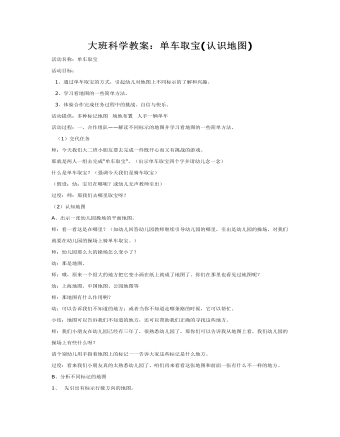
大班科学教案:单车取宝(认识地图)
2、学习看地图的一些简单方法。 3、体验合作完成任务过程中的挑战、自信与快乐。 活动提供:多种标记地图 场地布置 人手一辆单车 活动过程:一、合作组队——解读不同标示的地图并学习看地图的一些简单方法。 (1)交代任务 师:今天我们大二班小朋友要去完成一件既开心而又有挑战的游戏。 那就是两人一组去完成“单车取宝”。(出示单车取宝四个字并请幼儿念一念) 什么是单车取宝?(强调今天我们是骑车取宝) (假设:幼:宝贝在哪呢?或幼儿无声教师引出) 过度:师:那我们去哪里取宝呀?
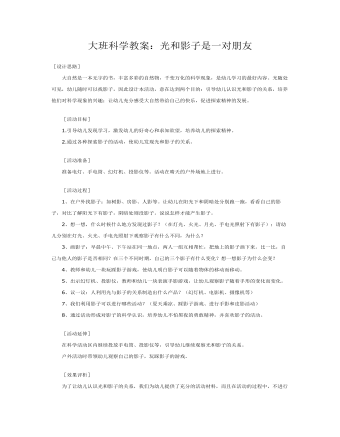
大班科学教案:光和影子是一对朋友
[活动目标]1.引导幼儿发现学习,激发幼儿的好奇心和求知欲望,培养幼儿的探索精神。 2.通过各种探索影子的活动,使幼儿发现光和影子的关系。 [活动准备] 准备电灯、手电筒、幻灯机、投影仪等。活动在晴天的户外场地上进行。 [活动过程]1、在户外找影子:如树影、房影、人影等。让幼儿在阳光下和阴暗处分别跑一跑,看看自己的影子,对比了解阳光下有影子,阴暗处则没影子。说说怎样才能产生影子。2、想一想,什么时候什么地方发现过影子?(在灯光、火光、月光、手电光照射下有影子);请幼儿分别在灯光、火光、手电光照射下观察影子有什么不同,为什么?3、画影子:早晨中午、下午站在同一地点,两人一组互相帮忙,把地上的影子画下来。比一比,自己与他人的影子是否相同?在三个不同时期,自己的三个影子有什么变化?想一想影子为什么会变?
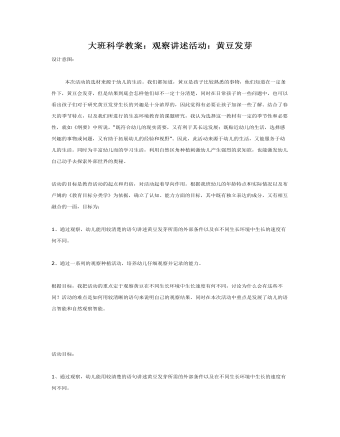
大班科学教案:观察讲述活动:黄豆发芽
活动的目标是教育活动的起点和归宿,对活动起着导向作用。根据我班幼儿的年龄特点和实际情况以及布卢姆的《教育目标分类学》为依据,确立了认知、能力方面的目标,其中既有独立表达的成分,又有相互融合的一面,目标为:1、通过观察,幼儿能用较清楚的语句讲述黄豆发芽所需的外部条件以及在不同生长环境中生长的速度有何不同。2、通过一系列的观察种植活动,培养幼儿仔细观察并记录的能力。根据目标,我把活动的重点定于观察黄豆在不同生长环境中生长速度有何不同,讨论为什么会有这些不同?活动的难点是如何用较清晰的语句来说明自己的观察结果。同时在本次活动中重点是发展了幼儿的语言智能和自然观察智能。活动目标:1、通过观察,幼儿能用较清楚的语句讲述黄豆发芽所需的外部条件以及在不同生长环境中生长的速度有何不同。2、通过一系列的观察种植活动,培养幼儿仔细观察并记录的能力。活动准备:1、知识准备:幼儿已经认识了空气,知道空气无处不在,月球上没有空气,万物就不能生长。2、实验准备:幼儿已经初步观察过在一般情况下黄豆的发芽情况;准备好在不同环境(水、沙、土)中已经发芽的黄豆以供幼儿观察。活动流程及环节:提出问题——进一步延伸问题——观察讨论——引出新问题、新实验一、提出问题:1、师提出问题:小朋友,前一段时间我们进行了黄豆发芽的实验,谁来告诉我,怎样才能使黄豆发芽?你看到的黄豆是怎样发芽的?先长什么?再长什么?颜色有些什么变化?

大班科学教案:常识活动设计:圆形的妙用
1.让幼儿在认识圆的基础上,通过做做、玩玩,让幼儿知道圆形的物体会滚动。2.知道用轮子能省力。3.发展幼儿的发散性思维。【活动准备】1.室外:(1)装有圆形轮胎的小三轮车、四轮车、小推车;(2)装有除圆形以外的各种形状轮胎的小三轮车、四轮车、小推车。2.室内:各种形状的小积木,幼儿人手一套;装有书籍的箱子一只,圆形的轮子两个,小推车一辆,大积木一块,每组一只盒子(装有橡皮泥、硬卡纸、彩色纸、剪刀、牙签、胶水、蜡笔)。【活动过程】一、第一次尝试:滚动圆形和其他形状构成的物体在室外供给幼儿装有圆形轮胎的小三轮车、四轮车、小推车以及装着除圆形以外的各种形状轮胎的小三轮车、四轮车、小推车。教师:“这里有许多车子,我们一起来玩一玩、想一想,哪些车子的轮子会滚动?”二、第二次尝试:圆形的东西会滚动1.在室内供给每位幼儿各种形状的积木玩。①你们的桌子上有什么形状的积木?②请你推动各种积木,你发现了什么?③为什么圆形的积木轻轻一推会滚,而梯形、正方形、长方形、三角形等的积木不会滚动呢?小结:圆形的东西会滚动,因为它没有角。
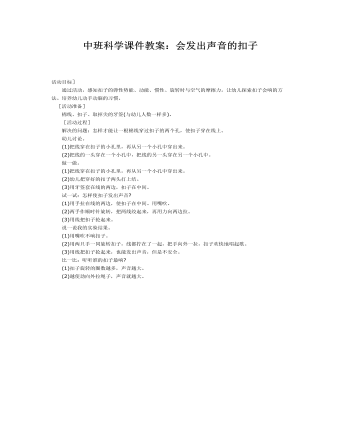
中班科学课件教案:会发出声音的扣子
[活动准备] 棉线、扣子、取掉尖的牙签(与幼儿人数一样多)。 [活动过程] 解决的问题:怎样才能让一根棉线穿过扣子的两个孔,使扣子穿在线上。 幼儿讨论。(1)把线穿在扣子的小孔里,再从另一个小孔中穿出来。(2)把线的一头穿在一个小孔中,把线的另一头穿在另一个小孔中。 做一做。(1)把线穿在扣子的小孔里,再从另一个小孔中穿出来。(2)幼儿把穿好的扣子两头打上结。
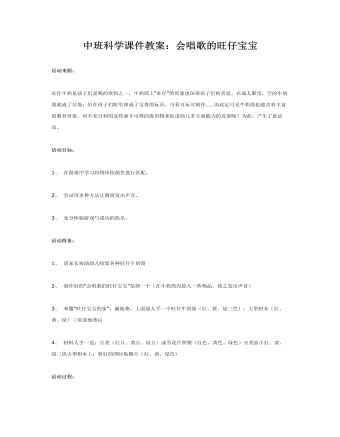
中班科学课件教案:会唱歌的旺仔宝宝
活动目标:1、 在游戏中学习将物体按颜色进行匹配。2、 尝试用多种方法让圆筒发出声音。3、 充分体验游戏与成功的快乐。活动准备:1、 请家长协助幼儿收集各种旺仔牛奶筒2、 制作好的“会唱歌的旺仔宝宝”范例一个(在牛奶筒内放入一些物品,使之发出声音)3、 布置“旺仔宝宝的家”:铺地垫,上面放人手一个旺仔牛奶筒(红、黄、绿三色);大型积木(红、黄、绿)三块放地垫后4、 材料人手一盒:豆类(红豆、黄豆、绿豆)或雪花片积塑(红色、黄色、绿色)分类放于红、黄、绿三块大型积木上;剪好的即时贴圆片(红、黄、绿色)
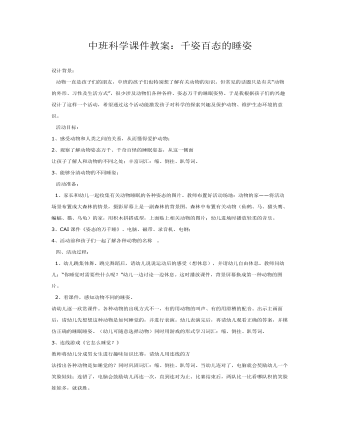
中班科学课件教案:千姿百态的睡姿
活动目标: 1、感受动物和人类之间的关系,从而懂得爱护动物; 2、观察了解动物姿态万千、千奇百怪的睡眠姿态,从这一侧面 让孩子了解人和动物的不同之处;丰富词汇:缩、倒挂、趴等词。 3、能够分清动物的不同睡姿; 活动准备: 1、家长和幼儿一起收集有关动物睡眠的各种姿态的图片。教师布置好活动场地:动物的家——将活动场景布置成大森林的情景,摄影屏幕上是一副森林的背景图。森林中布置有关动物(仙鹤、马、猫头鹰、蝙蝠、猫、乌龟)的家,用积木拼搭成型,上面贴上相关动物的图片;幼儿进场时播放轻柔的音乐。 3、CAI课件《姿态的万千睡》、电脑、磁带、录音机、电钢; 4、活动前和孩子们一起了解各种动物的名称 。
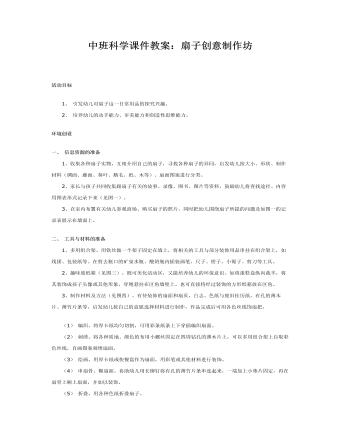
中班科学课件教案:扇子创意制作坊
2、培养幼儿的动手能力、审美能力和创造性思维能力。环境创设一、信息资源的准备1、收集各种扇子实物,互相介绍自己的扇子,寻找各种扇子的异同,启发幼儿按大小、形状、制作材料(绸面、藤面、葵叶、鹅毛、纸、木等)、扇面图案进行分类。2、家长与孩子共同收集跟扇子有关的故事、录像、图书、图片等资料,鼓励幼儿将查找途径、内容用图表形式记录下来(见图一)。3、在室内布置有关幼儿参观商场、购买扇子的照片,同时把幼儿围绕扇子所提的问题及如图一的记录表展示在墙面上。二、工具与材料的准备1、多用组合架。用铁丝做一个架子固定在墙上,将相关的工具与部分装饰用品串挂在组合架上,如线团、包装纸等。在剪去瓶口的矿泉水瓶、酸奶瓶内插装画笔、尺子、钳子、小锯子、剪刀等工具。2、趣味废纸箱(见图三)。既可美化活动区,又能培养幼儿的环保意识。如将蛋糕盒纵向裁半,将其装饰成孩子头像或其他形象,穿绳悬挂在区角墙壁上。也可直接将经过装饰的方形纸箱放在区角。3、制作材料及方法(见图四)。有待装饰的扇面和扇页,白志、色纸与废旧挂历纸,有孔的薄木片、薄竹片条等,启发幼儿按自己的意愿选择材料进行制作,作品完成后可用各色丝线饰扇把。
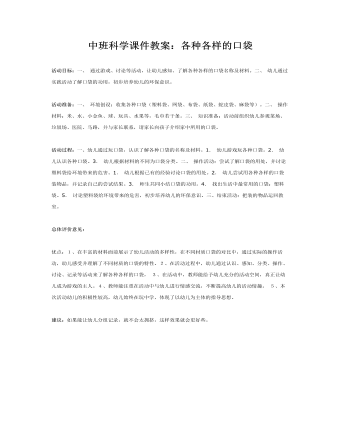
中班科学课件教案:各种各样的口袋
活动准备:一、环境创设:收集各种口袋(塑料袋、网袋、布袋、纸袋、蛇皮袋、麻袋等)。二、操作材料:米、水、小金鱼、球、玩具、水果等,毛巾若干条。三、知识准备:活动前组织幼儿参观菜场、垃圾场、医院、马路,并与家长联系,请家长向孩子介绍家中所用的口袋。 活动过程:一、幼儿通过玩口袋,认识了解各种口袋的名称及材料。1.幼儿游戏玩各种口袋。2.幼儿认识各种口袋。3.幼儿根据材料的不同为口袋分类。二、操作活动:尝试了解口袋的用处,并讨论塑料袋给环境带来的危害。1.幼儿根据已有的经验讨论口袋的用处。2.幼儿尝试用各种各样的口袋装物品,并记录自己的尝试结果。3.师生共同小结口袋的功用。4.找出生活中最常用的口袋:塑料袋。5.讨论塑料袋给环境带来的危害,初步培养幼儿的环保意识。三、结束活动:把装的物品运回教室。

